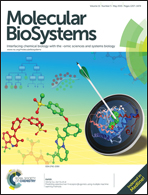Comparative transcriptome analysis between csrA-disruption Clostridium acetobutylicum and its parent strain†
Abstract
The genome of Clostridium acetobutylicum contains the gene encoding CsrA, a carbon storage regulator. We investigated the function of CsrA in C. acetobutylicum by insertionally inactivating the encoding gene, CA_C2209 using the ClosTron. Disruption of csrA obviously decreases the growth of the organism and reduces the yield of acetone, butanol and ethanol (ABEs). Like the csrA in Escherichia coli, RNA-seq and β-galactosidase analysis revealed that csrA in C. acetobutylicum was closely involved in regulating multiple pathways including flagella assembly, oligopeptide transporting, iron uptake, and central carbon metabolism. It has also been newly demonstrated that csrA in C. acetobutylicum is related to the regulation of pathways involved in the phosphotransferase transporting systems, synthesis of riboflavin, and stage III sporulation. This research represented the first investigation of global regulation by CsrA in the strain belonging to Gram-positive bacteria through transcriptome analysis and provided the important theoretical evidence for improving solvent production by transcriptor engineering in C. acetobutylicum.


 Please wait while we load your content...
Please wait while we load your content...